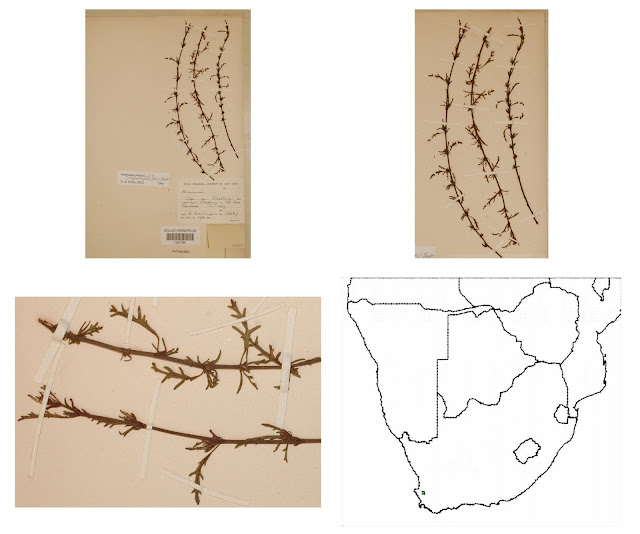An Amazing Finding:
I am a botanist who undertook a ten year PhD on a fascinating group of 250 plant species, the dolls roses. I recently found a new species of dolls rose growing on the roadside - a beautiful creature with an evocative scent, flame-coloured petals, heart-shaped leaves, and star-like hairs. I decided to tie in awareness of this flagship species, with an article on the value of roadside reserves to conservation. The key finding of my research is that the road reserves have a 25% higher diversity than the world’s richest nature reserve, Table Mountain National Park (TMNP). Additionally, these road reserves are more than seven times the area of TMNP. These delicate ecosystems are being systematically degraded by municipalities throughout the country, acting on insensitive, misguided and outdated legislation.
A Grave Shock:
Two weeks later I drove past the locality, and to my horror found two tractors with brushcutter attachments careening through the remaining natural vegetation, not two kilometres from the new species. Alongside were a team of seven workers wielding weedeaters, all bent upon the same task of pointless destruction. Although I tried stopping them, the massacre continues across the country. I have witnessed the loss of vegetation at the bulb capital of the world - Niewoudtville, the previously beautiful roadsides around Darling. For that reason, and 9600 others, we need to change legislation to conserve rather than destroy these man-made arteries of the world's smallest floral kingdom. Less than 3% of the renosterveld remains, and its diminishing fast. Its time to act before all we have left is weed infested grass.
The Plan:
To change legislation to conserve our flora I need to spread awareness and raise funds - urgently, so that the spring flowers have a chance to set seed, and the woody plants remain. Today I launch an auction of the right to name the new Hermannia, and for this enchanting pendant made by Nic Bladen (http://www.nicbladen.com/) cast from the flower of this new species. Bid at: http://bit.ly/16rmL2N.
Next week I embark on a series of talks, known as my my Springtacular to raise publicity and funds which would be to give evening talks at six venues across Cape Town. This is part of my lecture series in which I showcase the most astonishing plants I have encountered in my 17 years as a botanist. Book here (http://bit.ly/171fYxB), find updated information here at http://www.casabio.blogspot.com, or contact David directly on capebio@gmail.com or (South Africa) 072 368 9244
This is just a start. I also want to enthuse school children to become explorers of our own natural treasures, and thus give schools an opportunity to raise funds towards this objective. This forms part of my Bucks4Biodiversity programme.
So please. Spread the word of the auction (http://bit.ly/16rmL2N), come to the talk, or donate directly to the NGO:
http://www.casabio.org/sponsors.html
-TNB
Twitter: @TNBloganist
I am a botanist who undertook a ten year PhD on a fascinating group of 250 plant species, the dolls roses. I recently found a new species of dolls rose growing on the roadside - a beautiful creature with an evocative scent, flame-coloured petals, heart-shaped leaves, and star-like hairs. I decided to tie in awareness of this flagship species, with an article on the value of roadside reserves to conservation. The key finding of my research is that the road reserves have a 25% higher diversity than the world’s richest nature reserve, Table Mountain National Park (TMNP). Additionally, these road reserves are more than seven times the area of TMNP. These delicate ecosystems are being systematically degraded by municipalities throughout the country, acting on insensitive, misguided and outdated legislation.
A Grave Shock:
Two weeks later I drove past the locality, and to my horror found two tractors with brushcutter attachments careening through the remaining natural vegetation, not two kilometres from the new species. Alongside were a team of seven workers wielding weedeaters, all bent upon the same task of pointless destruction. Although I tried stopping them, the massacre continues across the country. I have witnessed the loss of vegetation at the bulb capital of the world - Niewoudtville, the previously beautiful roadsides around Darling. For that reason, and 9600 others, we need to change legislation to conserve rather than destroy these man-made arteries of the world's smallest floral kingdom. Less than 3% of the renosterveld remains, and its diminishing fast. Its time to act before all we have left is weed infested grass.
The Plan:
To change legislation to conserve our flora I need to spread awareness and raise funds - urgently, so that the spring flowers have a chance to set seed, and the woody plants remain. Today I launch an auction of the right to name the new Hermannia, and for this enchanting pendant made by Nic Bladen (http://www.nicbladen.com/) cast from the flower of this new species. Bid at: http://bit.ly/16rmL2N.
Next week I embark on a series of talks, known as my my Springtacular to raise publicity and funds which would be to give evening talks at six venues across Cape Town. This is part of my lecture series in which I showcase the most astonishing plants I have encountered in my 17 years as a botanist. Book here (http://bit.ly/171fYxB), find updated information here at http://www.casabio.blogspot.com, or contact David directly on capebio@gmail.com or (South Africa) 072 368 9244
This is just a start. I also want to enthuse school children to become explorers of our own natural treasures, and thus give schools an opportunity to raise funds towards this objective. This forms part of my Bucks4Biodiversity programme.
So please. Spread the word of the auction (http://bit.ly/16rmL2N), come to the talk, or donate directly to the NGO:
http://www.casabio.org/sponsors.html
-TNB
Twitter: @TNBloganist















